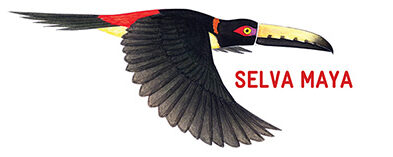STRENGTHENING THE REGIONAL STRATEGIC COOPERATION FOR THE PROTECTION OF THE SELVA MAYA
CONTEXT
The Selva Maya in the border area between Belize, Guatemala and southern Mexico is the largest contiguous tropical forest area in Mesoamerica with over ten million hectares. With 23 different ecosystems in over four million hectares of protected areas it is a hotspot of biodiversity. Its ecosystem services of water storage and supply in the region and its function as a carbon sink are threatened by unsustainable land-use, population growth and migration, illegal logging and trade in flora and fauna, oil extraction and ecosystem fragmentation. Furthermore, the degradation of ecosystems reduces their ability to adapt to the adverse effects of climate change.
In addition, environmental governance in the Selva Maya region is weak, and cross-border cooperation and coordination for the effective protection of the Selva Maya resources requires additional efforts to implement common mitigation strategies.
One of the components of the project is also focused on the development of a “One Health” approach, understood as the interface between ecosystems or protected areas, wildlife and human health. This approach follows the logic that environmental protection, for example reducing deforestation and wildlife trafficking, leads to the reduction of potential zoonotic risks and thus to the protection of human health. For this reason, the project seeks to initiate and establish an intersectoral dialogue, based on scientific evidence, to contribute to the reduction of zoonotic risks in the Selva Maya.
Challenges
SETTING GOVERNANCE PLATFORMS IN THE SELVA MAYA
In view of this challenge, the Strategic Coordination Group of the Selva Maya (GEC) was founded in 2015 as a joint effort of various actors from the three countries. It is composed of high-level representatives of the institutions responsible for the protection and conservation of protected areas it acts as a platform for political advocacy and decision-making. In addition, at the operational level of the protected areas, the Operational Coordination Group of the Selva Maya (GOC) was established, consisting of directors and deputy directors of protected areas in Selva Maya. This group operates as a technical-operational interest representation platform which coordinates and implements activities of cross-border cooperation.
However, the GEC cannot conclude agreements which are formally binding on each of the three countries and the GOC is based on the voluntary commitment of the protected area directors.
COUNTERPARTS
The lead executing agency is the Central American Commission on Environment and Development (CCAD). National counterparts are the Forest Department (FD) in Belize, the Guatemalan National Council for Protected Areas (CONAP) and the Mexican National Commission for Natural Protected Areas (CONANP).
APPROACH
To reach its objective, the project promotes activities along four thematic lines:
- Strengthening of the strategic coordination (at the level of the Strategic Coordination Group of the Selva Maya (GEC) and high-level decision-makers)
- Strengthening of the operational cooperation (at the level of the Operational Coordination Group of the Selva Maya (GOC))
- Implementation of local cooperation mechanisms (at the level of the Operational Coordination Group (GOC) and other local actors)
- Fostering an intersectoral dialogue for the reduction of zoonosis risks in the Selva Maya.
In this sense, the project seeks to foster the coordination and cooperation capacities of the Strategic and Operational Coordination Group of the Selva Maya (GEC and GOC) and to develop and strengthen coordination mechanisms between selected adjacent protected areas of the Selva Maya, and other relevant actors through capacity building measures.
Through improved intersectoral coordination and cooperation, natural resource protection measures will strengthen the dialogue at different levels, reducing the risk of zoonoses and future pandemics through concrete measures, including raising environmental awareness among the local population (more than 600,000 people in the region) and strengthening the scientific knowledge base.
Furthermore, the project aims to strengthen the communication capacity of the institutions to position the Selva Maya on a national, regional and international level and to raise awareness of its value locally.
CONTACT
Selva Maya Programme
Deutsche Gesellschaft für Internationale Zusammenarbeit (GIZ) GmbH
4ª. Calle 6-55 zona 9
01009 Ciudad de Guatemala
T +502 2312-2100
E [email protected]
I www.giz.de

